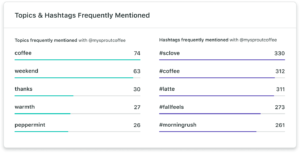How To Choose The Right Social Listening Tool [Checklist Included]
What Is A Social Listening Tool

A social listening tool is an online software that helps you measure and track mentions of your brand on social media and the web such as news sites and blog forums. A social listening tool pulls the conversations and gives you valuable insights into what is being said about your brand and how consumers feel about your products and services.
Why You Should Use A Social Listening Tool For Your Business

Depending on the size of your business and your goals, a social listening tool can help you achieve many things such as:
- Identifying keywords and hashtags used within your industry
- Finding the latest trends to get you ahead in the marketing game
- Identify the top influencers
- Finding your target audience based on age/geography/demographic
- Finding and solidifying your brand voice
- Tracking your competitors

These are some of the many ways social listening can help you with your brand’s social presence and help improve your marketing strategies by making well-informed decisions.
How To Choose The Right Social Listening Tool
Social listening provides valuable consumer data that you can leverage to better understand your brand awareness and improve the quality of your products and services. A social listening tool offers real-time metrics, provides intel on how consumers feel about your brand and can help measure the success of your marketing campaigns.
When selecting a social listening tool, there are 6 core areas to evaluate:
- Keyword Monitoring
- Social Platform Coverage
- Data & Insights
- Metrics Dashboard & Reporting
- Customer Support
- Pricing
Depending on your needs, you should seek out a tool that provides these key features to help you reach your online marketing goals. Read on as we break down each key feature and why they are important to consider when searching for your next social listening tool.
Keyword Monitoring
The first key factor you should look for in your social listening tool is the ability to do a keyword search. This is where it starts and how social listening works. By inputting specific keywords related to your brand, product, or service, listening tools pull conversations around keywords you input, from the channels and date range selected. Exclusions can also be used to “weed out” any irrelevant conversations.
In addition to keywords, hashtags you specify can also be pulled in.
At the minimum, all social listening tools allow you to input keywords and hashtags for keyword monitoring.
Another key factor to consider is if the tool offers multi-language filters. If your audience speaks other languages be sure to evaluate tools that have this capability.

Social Platforms
The point of social listening is being able to pull data from any social channel. A tool should offer the ability to do so from a wide variety of social platforms.
However, the key point to consider is identifying what platforms your audience is on most. Knowing where your consumers share their opinions and concerns is the best way to narrow down your focus and time to find the conversations that matter most. Consider choosing a tool that tracks mentions from these platforms:
- TikTok
- Twitch
- Discord
- Blogs/Forums
- YouTube
- News sites*
*While News sites are not “social” platforms, having a tool that can aggregate news mentions and provide insights on sources and publications where your brand appears is a great way to keep tabs on your brand and narratives being shared around it. It can also be useful for PR teams looking for new publications or to check story pickup among news publications.
Insights:
It’s one thing to have the data, but a tool that offers key insights to make sense of the metrics is an important feature a social listening tool should have to help you make informed business decisions. Some key insights a tool should include are:
Keyword metrics: The tool you choose should give you metrics around how many brand mentions there were in a given date range, what social platform it was mentioned on most, as well as keywords.
- Demographics*: A tool that includes demographic insights can inform you where geographically your brand is mentioned and what locations people are from who use your product or service.
- Gender/Age*: Is your brand geared more towards male or female or both? A social listening tool can provide the percentage of a particular gender or age discussing your brand. This can help you make informed decisions around the type of content you should put out.
- Sentiment Analysis: A good social listening tool should inform you how your consumers feel about your brand and products/services.
- Channel Insights: In-depth data for specific channels so you’re able to see where your audience congregates most and plan your content and community management strategies accordingly.
- Voice share of your brand: The share of voice your brand holds in the industry when compared with your competitors is a strong indicator of how well your brand is performing.
- Word clouds: Word clouds highlight commonly used words and phrases to identify important discussions and concerns around your brand
Analytics Dashboard
Your social listening tool should provide custom dashboards that include real-time data and analytics to help you monitor and track metrics and conversations. Here are a few areas your listening tool should provide data and metrics for:
- Campaign performance
- Content metrics
- Follower growth and audience tracking
- Overall Engagement
- Consumer conversation and sentiment
- Overall brand health
Dashboards help you share key insights with others on your team to help give the bigger picture and keep everyone informed.
**Bonus points if a tool allows you to download the dashboard as a PDF, CSV, PPT, or even share a link with non-tool users.
Customer Support & UX
When looking for key features in a social listening tool to help with your business goals, it’s imperative to also look for a tool that offers a customer support team to help you and your team with any issues/questions or troubleshooting needs. You also want to be sure the look and feel of the tool is intuitive, easy to navigate, and provides interesting and helpful visuals to aid in data storytelling.
To ensure you’re getting the optimal customer support check with the tool if they have any or all of these things:
- 1 on 1 demos prior to committing to the tool
- Dedicated account managers to help with troubleshooting and specific needs with your account
- Easy and responsive online support
- Onboarding support
Do as much research about the tool as possible so you understand exactly what you will be getting. G2 Crowd & Capterra are great resources that provide reviews around a myriad of different tools. Reviewers share the pros and cons of tool usage, as well as use cases for the tool that may be helpful in your search.
Pricing
Pricing is a very important factor when it comes to selecting a social listening tool. Tool costs vary based on features, sources, team seats, account management, and add-ons. Always compare prices between social listening tools and what each price model offers to see what works best with your budget.
Here are a few questions you should ask tool vendors when evaluating their services:
- Is there a trial before committing to purchase?
- What are the payment options?
- What is the ROI expected?
- Are there any limitations on mentions? Seats? Topics? Dashboards? If so, what are the costs?
- How is billing handled if we go over the limits?
You want to ensure the pricing models offered makes sense with the size of your team. Also, be sure there is enough conversation that can be pulled around your brand before investing in an expensive listening tool, as there are many free and low-cost options that may be sufficient.
The Checklist
The first step any business should take is to identify their goals for the tool before exploring any. Fill out the pop-up form to get your free checklist to help you decide on your next social listening tool.

![You are currently viewing How To Choose The Right Social Listening Tool [Checklist Included]](https://www.b3mediasolutions.com/wp-content/uploads/2022/06/B3.png)


